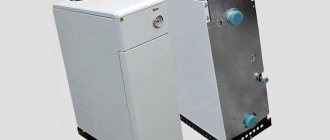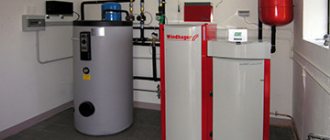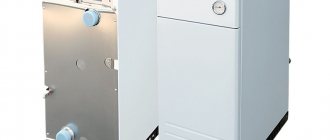Heating is an important issue that every home or cottage owner faces. In addition to choosing equipment, you need to decide on the heating fluid. More and more people are thinking about using oil rather than water for their home heating system. There are many opinions regarding this issue, which we will try to understand.
Heating is important
The issue of heating arises even during the design of a new house. Sometimes it appears when the operating mode changes. So, for example, a person could buy himself a country house, which the previous owners visited only in warm weather. Now he intends to visit it in late autumn and winter. What to do? Shouldn't you stay in a cold room? The answer is obvious - heating. It is important to choose which one and with what coolant. It depends on many factors.
Most people try to use water in their system, since it is the cheapest and most energy-intensive coolant. Moreover, if the temperature drops below zero, it will freeze. As a result, the system will have to be heated, and, at best, some burst pipes will have to be welded. At worst, you need to change the entire system, including the boiler. This situation is not only unpleasant, but also costly.
Therefore, in winter, special additives are used for water to prevent freezing. They come in different varieties, ranging from liquids with mineral salt to alcoholic ones. Each has its own positive and negative qualities. But still, none of them can be called ideal. It is in this regard that many people think not about what to add to the water, but what to replace it with.
Timing for oil changes
During operation of the transformer, an oil oxidation reaction occurs, dirt accumulates and the viscosity of the oil increases, which reduces its ability to cool the operating transformer. If the oil is not changed on time, the service life of the equipment is significantly reduced.
The average time to replace transformer oil is 1 year. And no more than after 5 years it is necessary to carry out drying and regeneration work. To extend the life of oil and equipment, you need to follow some rules:
- install an expander with a filter to absorb water and oxygen to prevent oil from contacting air;
- try not to bring the oil to maximum and long heating;
- carry out cleaning and drying in a timely manner;
- Perform continuous filtration of lubricants.
Advantages
Used oil in the heating system has many advantages:
- In winter, the liquid will not freeze. Unless the temperature in the house drops to -35 degrees Celsius. Agree, this is unlikely to happen.
- It doesn’t matter how long the negative temperature lasts, it does not affect the oil in any way. You can turn on the boiler and start heating the room at any time.
- Low volatility due to the structure.
- There is no need to additionally pour in any additives to prevent the coolant from freezing.
- The oil has high anti-corrosion properties. Therefore, there is no need to flush the system frequently.
- Has high thermal stability.
Properties
Transformer oil freezes at a temperature of -45 °C, which is of great importance when used in low-temperature climatic conditions. It also retains the ability to effectively remove heat at high temperatures: a mandatory condition is not lower than 90 °C, but there are oils with a temperature limit of 125, 135, 150 °C.
When the transformer operates, the oil heats up and oxidizes, aging. Accordingly, such an indicator as stability against oxidation decreases - the oil retains its original characteristics during further use. The higher the grade of oil, the longer the operating time without the need to replace it.
In our country, all types of transformer oil, which are used on industrial equipment, are necessarily inhibited by the additive ionol. This additive interacts with active radicals that arise during the oxidative reaction of hydrocarbons, which leads to a significant increase in the induction period. Thanks to the development of modern manufacturing technologies, modern oils are produced with high stability, which do not require the addition of inhibitors, with the exception of oil for very large heavy-duty transformers.
Transformer oil creates the conditions for the arc extinguishing environment. By lowering the temperature, insulation reduces copper consumption, noise and vibration. The normal color of fresh oil is light yellow. During use, under the influence of temperature and contamination by sediment and dirt, it darkens and becomes dark brown. Transformer oil is flammable, it decomposes without harm to the environment, is practically non-toxic, and does not harm the ozone layer.
Flaws
Despite the obvious advantages of this type of coolant, there are still a number of disadvantages:
- The need for filtration before injecting into the system. The fact is that usually the oil is a mixture of many oils of different brands and viscosity. In addition, it contains third-party components in the form of dirt and metal. The process of cleaning a considerable volume can cost a large sum.
- Availability of the required quantity. At the moment, there are no companies that are engaged in the targeted collection and purification of oil for future infusion into heating systems. Therefore, finding a sufficient amount of the desired consistency will be problematic.
- High fire hazard. In the event of a leak, there is a risk of fire. True, for this the liquid must come into direct contact with an open source of fire.
- It is not permissible to use a boiler with direct heating.
- Replacing all rubber gaskets and connectors with oil-resistant ones, which will be more difficult to find, since conventional heating systems are not equipped with them. In addition, their purchase can cost a large sum.
Manufacturing the main part of the boiler
It consists of a housing with a water jacket, an air supply channel and a tube through which the waste flows. At the bottom of the structure with a water circuit there is a door for removing the bowl. and also for igniting oil steam.
Making the base of a boiler for heating a house includes the following steps:
- Cutting two holes in a pipe with a diameter of 60 cm. The first, square, is made at the bottom, the second, round, is made not far from the top. As for the sizes, the bottom hole can have any size (the main thing is that the hand can fit and be able to pull out the bowl). The diameter of the top can be 14 cm.
- Welding to the cut holes of the necks. Their thickness should reach 5 cm.
- Welding a ring with a width of 3 cm to the bottom of the pipe. The ring (shell) is put on the end of the structure so that the planes of the two parts intersect at right angles.
- Preparing the outer pipe. Its length should be 0.5 cm less than the height of the inner part. The resulting gap will be closed with a weld. Holes are cut out in this pipe for the chimney, door, and coolant supply and return pipes. The last two are done at the top and bottom.
- Putting the outer pipe on the made structure and welding the two parts.
- Welding another ring. It is installed at the top, closing the space between the pipes.
- Welding of pipes for supply and return of water.
- Plug one of the pipes and check the tightness of the water circuit.
- Cutting 2 circles from sheet metal. The diameter of both is 66 cm. In one circle you need to make a hole for the air supply pipe. Hole diameter - 13 cm.
- Welding circles and the completed structure.
- Making a channel for air supply. This channel should be a tube with a diameter of 6-8 cm. The length of the tube can be 10-15 cm greater than the height of the structure made. One hole must be made in it. It should be at a distance of 50-60 cm from one end.
- Making a channel for oil supply. It will be placed inside the air supply pipe. To make it, take two pieces of tube with a diameter of 1 cm (the length of one is 45-50 cm, the second is 6-8 cm) and weld them so that the angle formed between them reaches 130-150 °.
- Installing the oil supply tube into the air supply channel. The principle of operation is for the short end of the tube to fit into the hole in the outer tube. The internal structure is centered in the external one and welded to it. It is desirable that the lower ends of both elements are at the same level.
- Placing the air duct into the boiler with your own hands and welding it to the top of the structure. It should be placed so that there is 25-30 cm between the lower end of the air supply channel and the bottom of the boiler for heating the house.
- Placing a bowl in a pipe boiler.
- Door fixation.
Peculiarities
Before pouring used oil into the system, it is important to check many nuances that will affect the work and comfort of residents in the future.
So, it is known that this coolant is fluid, even in the cold. But for conventional heating this is not enough. Warm and cooled oil have significantly different viscosities. Therefore, the pipes in the system must have the same diameter. And sometimes on return bends you can make it larger. The fact is that the boiler itself heats up quickly, but does not have time to push the oil through. In this case, even boiling is possible.
It is also important to think about the size of the expansion tank in advance. In aqueous systems, 10% of the total liquid volume is usually taken. With oil, things are a little more complicated, because when heated, it expands more than H2O. Despite this, the level in the system still needs to be checked from time to time and topped up if necessary. In such designs, it is recommended to install tanks measuring 30% of the total volume.
A particularly important condition in the matter of heating a house with used and already purified oil is tightness. In most cases, it is not possible to completely avoid leaks the first time. It is considered ideal to apply a new weld in such places, since gaskets and similar elements do not solve the situation. After this, the system starts up and is checked for complete tightness - small drops appear in places where there are even microscopic holes. In this case, it is advisable to drain all the oil and digest the problem areas. In this case, the procedure must be repeated until the system is completely corrected.
Precautionary measures
The main question of interest to consumers is how safe heating is. Complaints about an unpleasant odor from burning oil indicate non-compliance with the operating rules of the heating device.
It is important to make the right choice of mining. Its composition should not contain substances that can easily ignite, such as gasoline or acetone, and there should be no third-party additives
They are the ones who contaminate the burner section. When heating, the following safety precautions must be observed:
- The cross-section of the pipe must be at least 10 cm. The best option would be to use a sandwich chimney. A small amount of soot forms on its surface.
- Fuel containers should not be stored near the device.
- Containers with oil must be hermetically sealed. If water gets into the fuel, splashing will occur during burner operation, which increases the risk of fire.
- The temperature impact on a boiler with waste oil is much greater than on devices with solid fuel. Therefore, it is necessary to observe the thickness of the walls of the heat exchanger and combustion chamber (2 mm).
To avoid smoke and gas contamination in the boiler room, it is necessary to have a forced air circulation system. It is recommended to maintain air exchange with the following parameters: 180 cubic meters per hour per 1 sq. m. Only if these requirements for heating a country house are met, safe operation of the heating system is possible.
Self-made heating is quite economical and worthy of competing with other types of heating. Its specificity lies precisely in the used oil. This system is good if there are no other options or there is a sufficient supply of fuel. The main area of application for such structures is industrial enterprises where there is a large amount of waste oil.
Features of operation of heating equipment
Diagram of a factory-assembled boiler
Modern waste oil heaters are liquid fuel hot water boilers, which, if necessary, can be powered with other types of energy carriers.
Structurally, the equipment is a combination of the following elements:
- fuel supply pipe;
- preheating chamber;
- compressed air supply pipe with air mixture blower;
- burner with nozzle and blower;
- heat exchanger for one circuit or two heat exchangers for a double-circuit installation;
- exhaust gas removal system.
Diagram of a homemade burner for burning waste
The design of the device does not have a combustion chamber with an open flame. Moreover, the device does not contain elements that are subject to strong heating, which ensures an acceptable level of safety.
Among the advantages of the equipment, the following points should be noted:
- Affordable energy price, since waste can be purchased inexpensively at most car repair shops, service stations, etc.;
- High efficiency of the equipment and, as a result, the ability to heat both small dachas and full-fledged country houses;
- High fire safety of the heating process, since waste oil is characterized by mediocre flammability in comparison with other types of fuels and lubricants.
A more complex version of the previous scheme
Among the disadvantages of this heating method, we note the following points:
- Lack of fully automated equipment on the market;
- The need to build a special storage facility for fuels and lubricants;
- The need to arrange a special room for the boiler room;
- The need to establish contacts with organizations where you can purchase fuel.
How Gecko boilers function
To become familiar with the general principle of operation, it is necessary to familiarize yourself with the stages of converting fuel into thermal energy.
- Through the fuel line (9) the used oil enters the evaporator (11).
- Under the influence of temperature, the above-described transformation into gas occurs.
- Since it is lighter than air, the vapors rise through the vortex device (14).
- Passing through the holes in this element, they ignite in the afterburner.
- An air blower enriches the mixture with oxygen, which increases thermal output.
- Energy is transferred to the coolant (water, antifreeze) through the walls of the heat exchanger. They are in the afterburner.
To remove carbon monoxide, a flue is provided in the design. It is also designed to create draft that ensures the circulation of air flows inside the combustion chamber.
Making such a design with your own hands is not problematic. The main thing is to choose the right manufacturing material and act according to the developed technological scheme, taking into account the specifics of the drawing.
Types of coolants
1) Water
The most versatile and easily accessible coolant. It is this that is poured into the heating pipes of private houses in 70–80%.
There are a lot of advantages here: - it is easily accessible and free, has low viscosity and high fluidity (which means it will fit almost everywhere), non-toxic (which is very important), and transfers heat well. Perhaps these are the main advantages of water.
But there are also disadvantages: - the metal elements of the heating system rust over time and become unusable; if you heat the water to 80 degrees or higher, it deposits scale on the pipes, freezes at “0” temperature (which means you can’t leave a country house without heating for several days in winter ), when it freezes, it expands and will simply rupture your system; you need to constantly monitor the system with water inside; it is advisable to flush the system once a year to remove all kinds of deposits (rust and scale).
2) Antifreeze
Here it is necessary to distinguish between two types of antifreeze: ethylene glycol and propylene glycol.
Ethylene glycol is a cheaper type of antifreeze for your heating system. A big advantage is its resistance to low temperatures (holds up to -60 degrees), fluidity, low viscosity, and it practically does not enter into chemical bonds with metals (almost neutral), so it can work in the system for a very long time without flushing. Its thermal conductivity is higher than that of water, and accordingly it heats up faster (less gas is required for heating).
But the disadvantages are also significant, it is not cheap - you need to buy it, and it costs a lot of money and the biggest disadvantage is its toxicity, if it leaks in the house it is not good! It is because of toxicity that it is rarely used in private homes; it is usually used in industrial areas.
An environmentally friendly replacement for ethylene glycol was needed and it was found.
Propylene glycol - this composition has almost the same characteristics (does not freeze, has good contact with pipes and the heating system), but it is also non-toxic, so it can be poured into the heating system of a private home.
There are also disadvantages: - its thermal conductivity is lower than that of ethylene glycol (the difference is 15 - 20%), and its price is also higher than that of its poisonous friend, and significantly.
Therefore, new compounds had to be developed.
3) Antifreeze mixtures
As is clear from the name, the manufacturers decided to combine all the advantages of two non-freezing liquids - ethylene glycol and propylene glycol. If you choose the right composition, you get a completely environmentally friendly liquid with good thermal conductivity. This is exactly what you need to add to the system of your private home! Or if you are focused on the environment, you can look towards propylene glycol. Water as a coolant in the 21st century is practically losing its attractiveness, because although it is free, it comes into very strong contact with pipes and parts of heating boilers.
And that’s all, I think I’ve conveyed some information to you.
The most common today in most countries, including Russia, are heating systems filled with liquid coolant. This is a complex of equipment - complex or simple. In the latter case we are talking about an open circuit. As part of such systems:
- boiler rooms;
- heat exchangers;
- pumping equipment stations.
Ignition of the oil furnace
Unfortunately, the design does not have automatic ignition using piezo or electricity. The manipulations are complex and require experience:
- The condition of the unit is checked every time it is necessary to put it into operation. If necessary, the chimney and other channels are cleaned.
- Attention should be paid to the fuel tank to ensure that no water has entered it. What this entails is written above. In addition, it is important that there is a sufficient supply of fuel in the tank each time - 2-3 liters.
- Light the stove using a wick. They make it themselves, and the whole process is reminiscent of lighting a kerosene lamp. The oven does not set immediately, within 5 minutes. When stable combustion is ensured, the draft and other parameters for a productive process should be adjusted.
You can regulate the heat supply using devices on the unit itself. For this purpose there are dampers, valves, etc.
Conclusion
Now you know what heating systems are based on boilers running on waste oil. Moreover, you could get acquainted with general information about the profitability of using such systems.
All that remains is to consider the prospect of using this equipment in your country house and make the appropriate choice, which the video in this article will certainly help you with.
Did you like the article? Subscribe to our Yandex.Zen channel
Is it possible to use a boiler during mining to heat a residential building?
- Pre-evaporation of fuel - inside the structure there is a bowl in which partial combustion of fuel is carried out with constant and intense evaporation from the surface. Oil product vapors are burned in a separate chamber. The operating principle is similar to that used by pyrolysis boilers.
- Flare boilers are universal, capable of being converted to any type of liquid fuel (waste oil, waste oil, diesel fuel), as well as natural gas. The design of the burner for waste oil resembles that used in conventional liquid fuel units operating on liquid fuel. During operation, it is not the waste that is burned, but the fuel-air mixture, consisting of finely dispersed droplets. Passing through the nozzle under pressure, the liquid is sprayed and ignited using electrodes.
Water use
Before deciding what to fill the heating system in a private home with, you should consider the most common options for solving this issue. One of them is water, the advantages of which are expressed in the highest heat capacity among all liquids, as well as a lower density. Thus, a kilogram of water whose temperature is 90 °C will cool to 70 °C, releasing heat in the amount of 20 kcal.
When deciding what to pour into the heating system of a private house with an electric boiler, you can consider water as an option, which differs in environmental and toxicological properties from synthetic substances. It is safe for humans, and if a leak occurs, it will not cause additional trouble. Such a coolant can be easily obtained; if there is insufficient volume, pour the required amount into the system. This coolant has no competitors in price; a cheaper liquid simply cannot be found.
Do-it-yourself boiler being tested. Homemade boilers being tested
The main problem of many of our homeowners is the ever-increasing energy tariffs. Therefore, it is easy to explain that many of them are constantly looking for alternative heating methods. In recent years, solid fuel boilers have become especially popular, which can be heated not only with coal, but also with wood.
But you need to buy firewood and coal. But what if you need to heat a large garage or production workshop? After all, taxes are already far from the most humane, and therefore you always want to somehow minimize expenses.
Problems can be effectively resolved by an exhaust boiler. Making this heating device with your own hands is quite easy. By spending money only on the material, you will eventually be able to heat even large rooms for free (or for pennies), while at the same time fighting environmental pollution.











